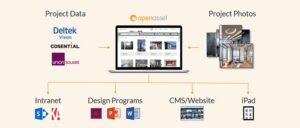The Pros and Cons of Digital Asset Management
Jun 4, 2019

The volume of digital assets being created and used by businesses is proliferating. Moreover, with it, so too is the need to manage assets effectually. With the size of image libraries in the Architecture, Engineering, and Construction (AEC), and Real Estate industries, the benefits of Digital Asset Management are clear.
However, as with the implementation of any system, it’s crucial to weigh up the pros and cons of introducing new software into your firm’s workflow. Getting value from DAM requires some careful considerations, from choosing the right software option to understanding the long-term administration demands.
Furthermore, understanding the Return On Investment for your business is crucial in selling the concept to stakeholders who might not immediately see the benefits of a Digital Asset Management system.
So let’s take a look at the whole picture; what do we need to consider?
What Is Digital Asset Management?
Back to basics; what is Digital Asset Management (DAM)? In simple terms, it’s the process of managing digital content in a single hub. However, DAM is much more than just a storage space. As well as providing an organized and searchable environment; above all else, a DAM offers the ability to manage the whole lifecycle of a digital asset. Assets need to be created, managed, distributed, and then either preserved or archived. Extensive collections of media assets also need to be available on-demand to employees across the organization.
What Digital Asset Management solutions are available?
There are two primary types of Digital Asset Management solutions: project, and product or brand-based.
A project-based DAM, as the title suggests, connects digital assets to specific projects. This is especially helpful for companies that need to search for assets by location, project lead, or project number.
In the AEC and Real Estate industries, a project-based DAM simplifies the marketing process for projects and properties. Well organized and appropriately tagged assets are easy to find and utilize, particularly when combined with a system that integrates with common applications.
The alternative to project-based DAM systems is product or brand-based solutions. In contrast, these systems centralize assets around brands or products.
The most common type of modern digital management software is SaaS (Software as a Service). This is cloud-based software that is accessed remotely via the internet, rather than being installed directly on a machine. No requirement for internal hardware or servers means reduced concerns over maintenance, which consequently means a SaaS solution is easily scalable.
What’s more, as the software isn’t linked to specific devices, users can access it anywhere and anytime. The cloud-based system results in less administration, backups are automated, and it integrates easily with existing systems. The start-up cost for SaaS is relatively low and, as there are no download requirements, updates are available to all users instantaneously.
What are the Benefits of Digital Asset Management?
Regardless of what software you choose to manage your digital assets with, implementing DAM has distinct advantages. The benefits of Digital Asset Management include:
- Time savings – using metadata to tag digital assets significantly reduces the time users spend finding what they need. Consequently, employees can focus on delivering a finished piece of work, rather than wasting time searching network drives. What’s more, content can’t be lost in a DAM, meaning you’ll never have to worry about the cost of recreating lost assets.
- Ease of reusing and repurposing assets – with DAM, the process of editing, repurposing and distributing assets can be done in within the software, removing the need for external editing and sharing apps.
- Improved workflows – a DAM automates workflows, ensuring that projects keep moving. Users can be alerted to targets and deadlines.
- Ensured brand consistency– as all digital assets are controlled in one place, Brand Managers can be confident that off-brand or out of date assets are no longer available to users.
- Maximized asset value – stored centrally and instantly available, DAM means employees can harness earning potential from these assets. Find and maximize revenue on your resources by easily conducting reviews.
- Facilitated data analysis – Digital Asset Management software includes tools that allow your organization to forecast revenue, conduct market research, and carry out data analysis.
- Supported business growth – A DAM is a scalable solution. This means that as your business grows and the number of digital assets increases, your power to manage them grows accordingly.
What are the challenges of Digital Asset Management?
In the digital age, it’s hard to put forward a strong case against using DAM. However, the adoption of any new system requires careful assessment to make certain it merits the time and cost of implementation. For your organization to see the benefits of Digital Asset Management, you need to consider the following points:
Ownership & user adoption
Digital Asset Management needs to be embraced by the whole organization to be productive; users must be consulted to ensure the solution fits their needs. Once a system is in place, users need to be trained and supported.
There will also need to be a DAM ‘owner’ within the business, someone responsible for managing the DAM daily. Without ownership, user buy-in, and a proper roll out to the business, you risk implementing a system that isn’t used to its full potential.
Integration
A DAM is at its best when integrated with other systems and applications that you already use. Integration ensures consistency and saves time when managing assets across multiple systems.
A DAM system also needs an API, meaning it can ‘talk’ to, and transfer data between systems. Without an API, you will need to transfer data manually; transferring files manually is a time and money consideration, particularly as your digital asset library grows.
Metadata
One of the main benefits of Digital Asset Management is the speed and ease in which you can search thousands of files. This is achieved by tagging assets with what’s known as ‘metadata’. However, no DAM system will perform optimally if assets are poorly tagged; for this reason, investing time upfront in planning the keywords you will use when creating assets will ensure the long-term health of your DAM.
Remember, if you can’t find it, then you can’t use it – you need to organize your files and describe them in a way that facilitates search. Fortunately, the growth of Artificial Intelligence (AI) in DAM means that tagging digital assets is becoming easier than ever. A DAM with AI means that images can be identified automatically and tagged accordingly, and as a result, further reductions in digital asset admin are possible.
Cost
As your organization grows, you will need to consider the continuing cost of your DAM system. One of the strengths of cloud-based DAM is its scalability. Although costs may seem high at first, these need to be balanced against the Return On Investment (ROI) over time.
What is the Return On Investment for Digital Asset Management?
Determining the ROI for your DAM isn’t always a straightforward calculation, although it is measurable with a bit of work.
Value Your Assets
Start by putting a value on your digital assets themselves – considering the cost of creating the asset and the potential cost of recreation, should you lose the asset. The cost of recreation is particularly relevant within the AEC and Real Estate industries, where the photos are vital to their success.
The next consideration is the size and complexity of your organization. You will need to evaluate the needs across your business, for example, how many users you have, their location, etc. The larger your access requirements are, the more significant your ROI will be.
It’s worth bearing in mind that ROI isn’t a static figure. ROI should be continually evaluated as part of a DAM strategy to ensure the system is working for your business and delivers what users need.
For every organization, creating and acquiring more digital assets continually increases the administrative burden. This means that the need for effective management becomes more acute over time.
There are pros and cons to consider, but for the most part, the benefits of Digital Asset Management certainly outweigh any challenges in the setup. DAM is a scalable solution that can grow with your business. By ensuring the solution meets your organization’s needs, has company-wide buy-ins, and you’ll reap the rewards.





